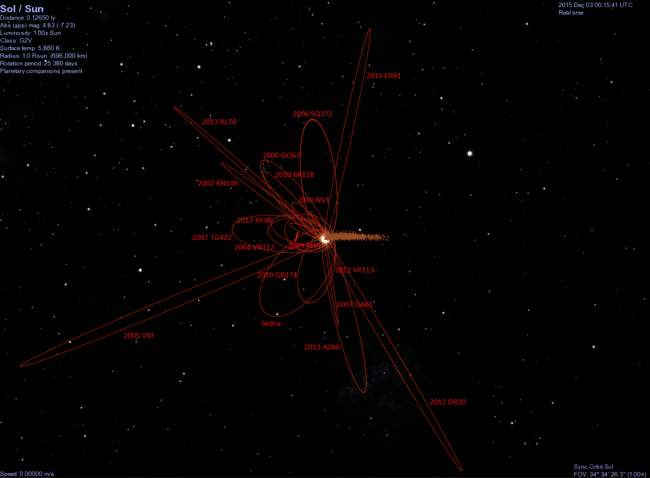(87269) 2000 OO67
| Discovery | |
|---|---|
| Discovered by | Cerro Tololo telescope |
| Discovery date | 29 July 2000 |
| Designations | |
| none | |
|
TNO Centaur (DES)[1] | |
| Orbital characteristics[2] | |
| Epoch 13 January 2016 (JD 2457400.5) | |
| Uncertainty parameter 2 | |
| Observation arc | 2187 days (5.99 yr) |
| Earliest precovery date | 29 July 2000 |
| Aphelion | 1,013.504 AU (151.6180 Tm) |
| Perihelion | 20.7726 AU (3.10754 Tm) |
| 517.138 AU (77.3627 Tm) | |
| Eccentricity | 0.95983 |
| 11760.29 yr (4295446.2 d) | |
Average orbital speed | 0.88 km/s |
| 0.328967° | |
| 0° 0m 0.302s / day | |
| Inclination | 20.0729° |
| 142.391° | |
| 212.345° | |
| Uranus MOID | 1.82 AU (0.272 Tm)[3] |
| TJupiter | 5.265 |
| Physical characteristics | |
| Dimensions | 38–86 km[4] |
| Temperature | ~12 K |
| 9.2[2] | |
|
| |
(87269) 2000 OO67 (also written (87269) 2000 OO67) is a small trans-Neptunian object (TNO) discovered by the Deep Ecliptic Survey in 2000. It is remarkable for its highly eccentric orbit. At aphelion it is over 1,000 AU from the Sun and, with a perihelion of 21 AU, almost crosses the orbit of Uranus at closest approach. Some astronomers list it as a centaur.[1][5]
(87269) 2000 OO67 came to perihelion in April 2005.[1][2][6]
Both (87269) 2000 OO67 and (308933) 2006 SQ372 take longer than Sedna to orbit the Sun using either heliocentric coordinates or barycentric coordinates.
Comparison

Sedna compared to some other very distant orbiting bodies including 2015 DB216 (orbit wrong), 2000 OO67, 2004 VN112, 2005 VX3, 2006 SQ372, 2007 TG422, 2007 DA61, 2009 MS9, 2010 GB174, 2010 NV1, 2010 BK118, 2012 DR30, 2012 VP113, 2013 BL76, 2013 AZ60, 2013 RF98, 2015 ER61
See also
- 2002 RN109
- 2005 VX3
- (308933) 2006 SQ372
- 2007 TG422
- 2010 EC46
- TAU (spacecraft) (probe designed to go 1000 AU in 50 years)
References
- 1 2 3 Marc W. Buie. "Orbit Fit and Astrometric record for 87269" (2006-07-25 using 33 of 34 obs). Deep Ecliptic Survey. Retrieved 2008-05-18.
- 1 2 3 "JPL Small-Body Database Browser: 87269 (2000 OO67)" (2006-07-25 last obs). Retrieved 12 April 2016.
- ↑ "(87269) = 2000 OO67". IAU minor planet center. Archived from the original on 2013-06-26. Retrieved 2017-02-22.
- ↑ "Absolute Magnitude (H)". NASA/JPL. Retrieved 2014-02-16.
- ↑ Structure and Dynamics of the Centaur Population: Constraints on the Origin of Short-Period Comets
- ↑ Yeomans, Donald K. "Horizons Online Ephemeris System". California Institute of Technology, Jet Propulsion Laboratory. Retrieved 2008-01-25.
External links
- List Of Centaurs and Scattered-Disk Objects at the Minor Planet Center
- (87269) 2000 OO67 at the JPL Small-Body Database
This article is issued from
Wikipedia.
The text is licensed under Creative Commons - Attribution - Sharealike.
Additional terms may apply for the media files.